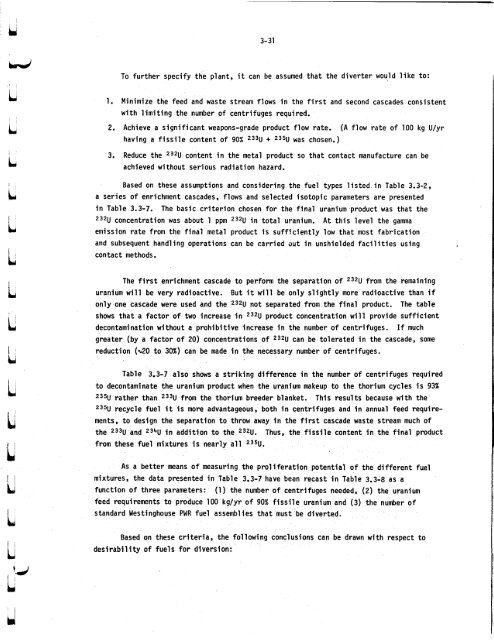ORNL-5388 - the Molten Salt Energy Technologies Web Site
ORNL-5388 - the Molten Salt Energy Technologies Web Site
ORNL-5388 - the Molten Salt Energy Technologies Web Site
Create successful ePaper yourself
Turn your PDF publications into a flip-book with our unique Google optimized e-Paper software.
Y<br />
tpr)<br />
Lj<br />
b<br />
L<br />
L<br />
L<br />
1<br />
L<br />
t<br />
b<br />
L<br />
L<br />
id<br />
il<br />
i,<br />
3-31<br />
To fur<strong>the</strong>r specify <strong>the</strong> plant, it can be assumed that <strong>the</strong> diverter would like to:<br />
1. Minimize <strong>the</strong> feed and waste stream flows in <strong>the</strong> first and second cascades consistent<br />
with limiting <strong>the</strong> number of centrifuges required.<br />
2. Achieve a significant weapons-grade product flow rate. (A flow rate of 100 kg U/yr<br />
having a fissile content of 90% 233U t 235U was chosen.)<br />
3. Reduce <strong>the</strong> 232U content in <strong>the</strong> metal product so that contact manufacture can be<br />
achieved without serious radiation hazard.<br />
Based on <strong>the</strong>se assumptions and considering <strong>the</strong> fuel types listed in Table 3.3-2,<br />
a series of enrichment cascades, flows and selected isotopic parameters are presented<br />
in Table 3.3-7. The basic criterion chosen for <strong>the</strong> final uranium product was that <strong>the</strong><br />
232U concentration was about 1 ppm 232U in total uranium.<br />
emission rate from <strong>the</strong> final metal product is sufficiently low that most fabrication<br />
and subsequent handling operations can be carried out in unshielded facilities using<br />
contact methods.<br />
At this level <strong>the</strong> gama<br />
The first enrichment cascade to perform <strong>the</strong> separation of 232U from <strong>the</strong> remaining<br />
uranium w ill be very radioactive. But it will be only slightly more radioactive than if<br />
only one cascade were used and <strong>the</strong> z32U not separated from <strong>the</strong> final product. The table<br />
shows that a factor of two increase in Z32U product concentration will provide sufficient<br />
decontamination without a prohibitive increase in <strong>the</strong> number of centrifuges. If much<br />
greater (by a factor of 20) concentrations of 232U can be tolerated in <strong>the</strong> cascade, some<br />
reduction (420 to 30%) can be made in <strong>the</strong> necessary number of centrifuges.<br />
Table 3.3-7 also shows a striking difference in <strong>the</strong> number of centrifuges required<br />
to decontaminate <strong>the</strong> uranium product when <strong>the</strong> uranium makeup to <strong>the</strong> thorium cycles is 93%<br />
235U ra<strong>the</strong>r than 2331) from <strong>the</strong> thorium breeder blanket. This results because with <strong>the</strong><br />
235U recycle fuel it is more advantageous, both in centrifuges and in annual feed require-<br />
ments, to design <strong>the</strong> separation to throw away in <strong>the</strong> first cascade waste stream much of<br />
<strong>the</strong> 233U and 2341) in addition to <strong>the</strong> 232U. Thus, <strong>the</strong> fissile content in <strong>the</strong> final product<br />
from <strong>the</strong>se fuel mixtures is nearly all 235U.<br />
As a better means of measuring <strong>the</strong> proliferation potential of <strong>the</strong> different fuel<br />
mixtures, <strong>the</strong> data presented in Table 3.3-7 have been recast in Table 3.3-8 as a<br />
function of three parameters: (1) <strong>the</strong> number of centrifuges needed, (2) <strong>the</strong> uranium<br />
feed requirements to produce 100 kglyr of 90% fissile uranium and (3) <strong>the</strong> number of<br />
standard Westinghouse PWR fuel assemblies that must be diverted.<br />
Based on <strong>the</strong>se criteria, <strong>the</strong> following conclusions can be drawn with respect to<br />
desirability of fuels for diversion:



![Review of Molten Salt Reactor Physics Calculations [Disc 2]](https://img.yumpu.com/21979492/1/190x247/review-of-molten-salt-reactor-physics-calculations-disc-2.jpg?quality=85)












